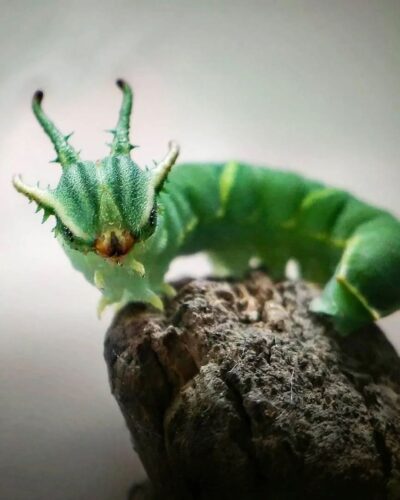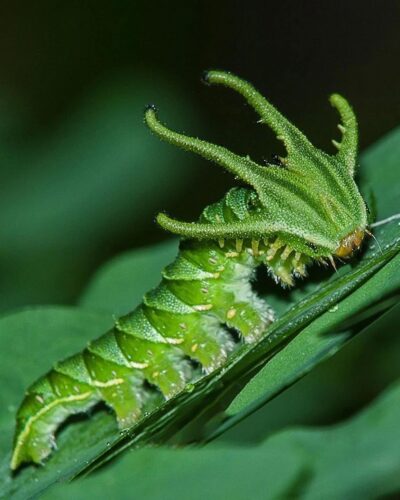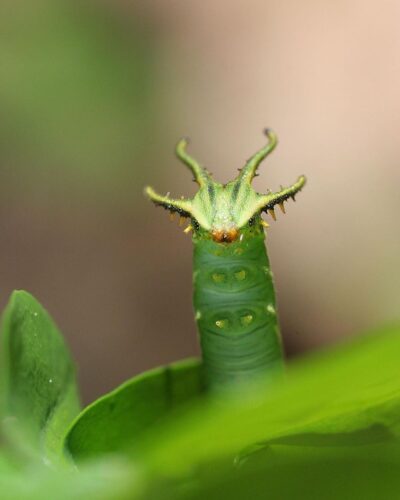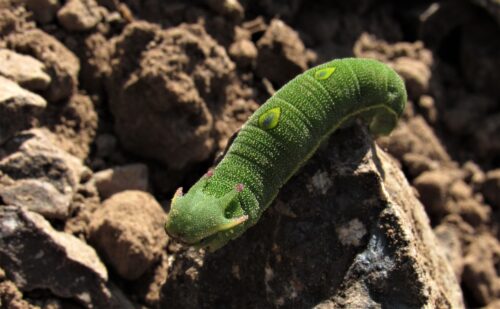Explore the Dragon-Headed Caterpillar Facts and Adventures in this interesting guide covering most aspects of their lives.
Discover the intriguing world of Dragon-Headed Caterpillar Facts and Adventures. Learn about their unique features, from horned head capsules to color-changing abilities.
Dragon-Headed Caterpillar Scientific Name: Polyura athamas
Common Names: Dragon-headed Caterpillars, Common nawab
Find So, What Do Leaf Bugs Eat?
What is a Dragon-Headed Caterpillar?

Dragon-headed caterpillars display various shapes and colors. They’re plant-eaters and transform into butterflies. Similar to regular caterpillars, they’re ordinary in behavior. After emerging, they consume leaves until metamorphosis. They inhabit temperate or tropical forests worldwide – North/South America, Asia, and Australia. Lifespan is around 1 month. Size varies – 3mm to 6mm initially, growing to 30mm. Weight is unknown. Usually green with green or black heads, sometimes with white or red marks. Their diet consists of leaves and plants. Predators include birds and amphibians. They can move up to 5mph. Over 400 species exist.
Check Japanese Beetle vs. June Bug
What Does a Dragon-Headed Caterpillar Turn Into
The “dragon-headed caterpillar” transforms into a butterfly called the common nawab through a process called metamorphosis. The caterpillar’s unique appearance changes dramatically during its growth stages. After entering the pupal stage and undergoing significant transformations, it emerges as a beautiful butterfly with intricate wing patterns.
Find What Does It Mean When a Butterfly Lands on You?
Dragon-Headed Caterpillar Life Cycle

The life cycle of a dragon-headed caterpillar consists of five stages, referred to as instars. At each instar, the caterpillar molts and experiences growth, becoming slightly larger. By the conclusion of the fifth instar, these initially tiny caterpillars, which began at a mere 3mm in size, will have enlarged tenfold, often reaching lengths of around 30mm.
To provide a visual comparison, 30mm is slightly shorter than the diameter of a United States quarter coin. This transformation from a minuscule size to a significantly larger one showcases the caterpillar’s remarkable growth during its journey toward becoming a mature butterfly.
FIND Everything About What Do Moths Eat?
Are Dragon-Headed Caterpillar Poisonous

Dragon-headed caterpillar has various ways to deter predators. Their distinctive head capsules with four horns serve as visual deterrents, discouraging attackers. Some variations take a more active approach by possessing a venomous sting, injecting toxins into potential threats.
This combination of visual intimidation and venomous defense showcases their adaptability and highlights to protect themselves and survive in nature.
Check White Butterfly Meaning and Sighting
Dragon-Headed Caterpillar Facts and Adventures

1. Dragon-Headed Caterpillar has 400 Species
While the number might appear significant at first, the situation is a little more intricate. The dragon-headed caterpillar isn’t exactly a single type of creature. Instead, it’s the early stage in the life of 400 different butterfly species.
Additionally, the larva of the plain nawab butterfly stands out distinctly. It has a vibrant green body resembling a slug and black horns. Yet, some of them have entirely green heads, while others might even display eye-catching red marks.
2. Dragon-Headed Caterpillar Change Colors
Numerous dragon-headed caterpillar species begin with entirely black heads at birth. Yet, as they mature, changes extend beyond size. Some experience their black head gradually transitioning to green. Additional colors like white stripes or red-tipped horns might emerge. However, certain caterpillars retain their black head until they metamorphose into butterflies.
3. Dragon-Headed Caterpillar Eat their Eggs
Dragon-headed caterpillars can display a surprising behavior: they eat their own eggs. This unusual behavior may help them gain nutrients or protect against parasitic wasps that lay eggs on them. It’s a remarkable adaptation that showcases the intricate ways insects have evolved to survive in their environments.
4. Some Varieties can give a Sting
Many types of dragon-headed caterpillars scare away predators by having head capsules with four horns. This keeps them safe from becoming someone’s meal. However, some types of these caterpillars use an extra trick to stay safe: they have a venomous sting.
Unlike animals that use their sting to attack, like scorpions, the dragon-headed caterpillar defensively uses its sting. It means the sting only hurts when something tries to pick it up, like a hungry bird. You don’t have to worry if you leave them alone and don’t touch them.
Also, not all types of these caterpillars have this painful sting. But if you’re not sure which ones do, it’s probably best to avoid touching them altogether!
Do Butterflies Drink Blood? FIND OUT
5. The Look of Dragon-Headed Caterpillar Rely on Their Surroundings
With so many variations and shifts in looks, you might wonder if there’s a method behind it. It’s actually not entirely random!
The dragon-headed caterpillar’s well-known head capsule isn’t just for show – it’s a survival tool. Depending on where they live and the predators around, these caterpillars might appear a bit different. These appearance changes help boost their chances of making it to adulthood successfully.
6. Dragon-Headed Caterpillar’s Are Still a Mystery
Even with more than 400 species globally, there’s much we’re uncertain about regarding these creatures. In certain cases, we’re not even sure about their lifespan!
7. Scientific Exploration
Researchers continue to delve into the lives of dragon-headed caterpillars, unraveling their mysteries. Scientific adventures lead to a deeper understanding of their roles in ecosystems.
8. Educational Opportunities
Dragon-headed caterpillars offer an exciting platform for learning about biodiversity, adaptation, and ecological interactions. Their adventures inspire curiosity and appreciation for the natural world.
9. Conservation Concerns
Understanding Dragon-headed caterpillar adventures is vital for their conservation efforts. As their habitats face challenges, safeguarding dragon-headed caterpillar populations becomes essential to the conservation narrative.
Read White Praying Mantis Information and Meaning Guide
10. Surviving Changing Landscapes
Dragon-headed caterpillars face the challenges of adapting to changing environments. As their habitats experience alterations due to factors like urbanization or climate change, these caterpillars must navigate new conditions. This adventure involves finding suitable food sources, evading new predators, and coping with altered climates—an ongoing saga of resilience in the face of environmental shifts.




